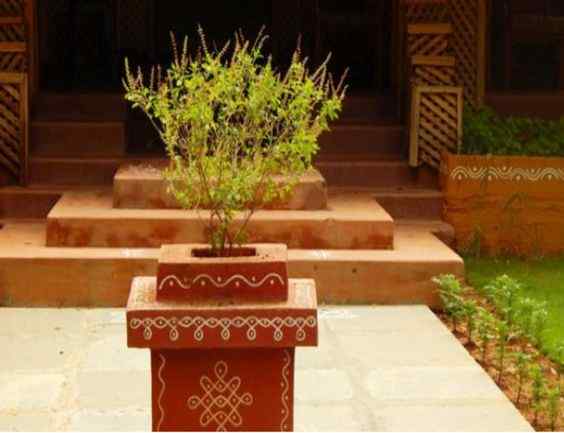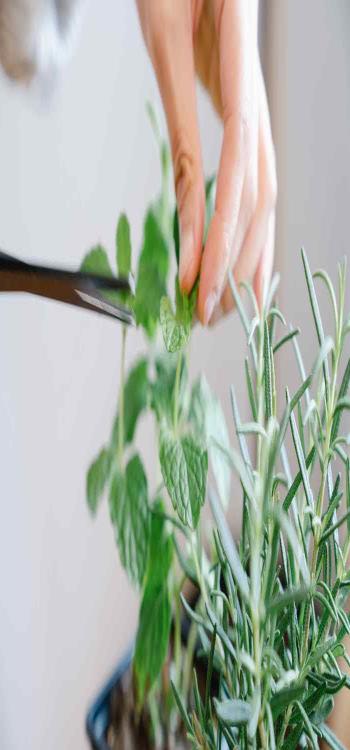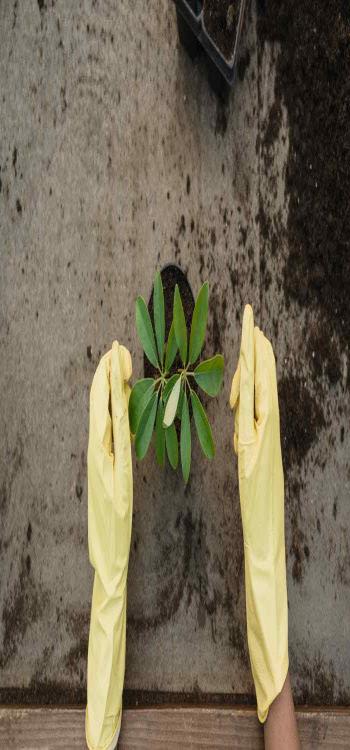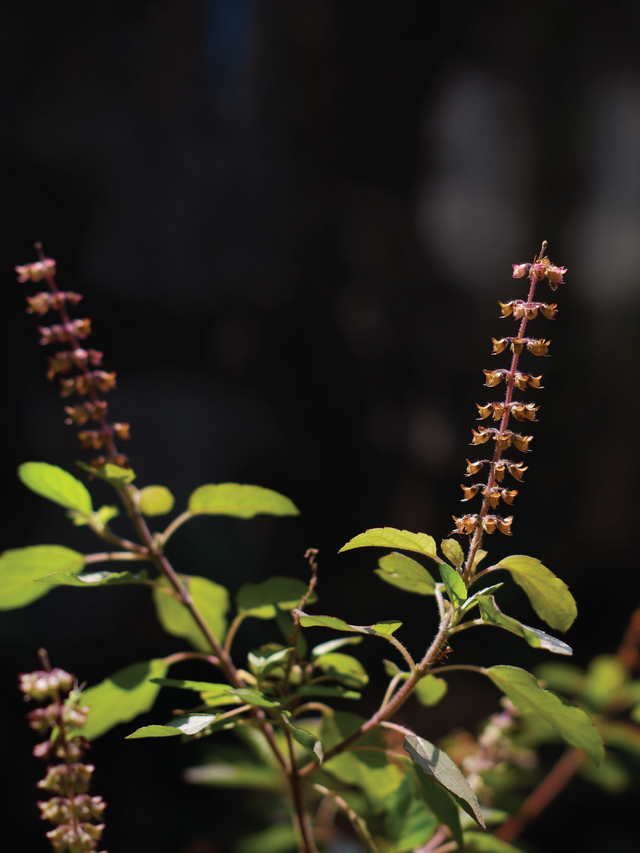In India, Tulsi is revered as a sacred plant because of its medical powers and is typically seen in the homes of Hindus. Also called basil, this plant helps remedy different seasonal disorders such as common cold, flu and cough. Tulsi Plant Vastu dictates the ideal placement and care of this sacred plant to maximise its positive influence on your home.

Things we covered for you
According to Vastu, a Tulsi plant at home promotes peace and harmony among family members. So, where should you put your Tulsi plant? And which Tulsi is best for home as per Vastu? To attract good fortune, follow this Vastu article to get the best results for the family members and also educate others about the directions and instructions as per Vastu – where to keep the Tulsi plant.
Tulsi Plant Health Benefits For The House
These are some of the benefits of tulsi plant at home:
Reduces the effects of stress – The Journal of Ayurveda and Integrative Medicine states that the presence of Tulsi in your home is recognised to defeat stress.
Keeps mosquitoes away – Tulsi, or holy basil, is well-known for its effectiveness as a natural insect repellent. According to the Journal of Malaria, this plant deters insects and mosquitoes. This is why it’s critical to keep Tulsi inside, particularly during the rainy season.
Keep the air fresh and clean – The Tulsi plant at home promotes the flow of oxygen into your sleep space. Oxygen is produced by this plant 24 hours a day, seven days a week, and hazardous pollutants like carbon monoxide, carbon dioxide, and sulphur dioxide are removed from the atmosphere by this plant.
Provides fragrant scent – Holy basil’s wonderful perfume refreshes the air and infuses your house with a nice aroma. This herb also has mood-enhancing qualities.
Fights off illness – Tulsi is effective in the battle against sickness. Tulsi may be brewed with tea and used as a remedy in the event of a cold, cough, or fever. Tulsi and cardamom may be combined in a cup of water and made into tea. Blood purifier and cholesterol-lowering agent: it’s a terrific choice.
Reduce kidney stones – Tulsi leaves might also help you get rid of kidney stones. To get rid of kidney stones at home, Tulsi leaves and a spoonful of honey should be consumed daily.
Where To Place Tulsi Plants At Home?

If you want to create a basic Tulsi mandir design at home, Vastu Shastra offers certain guidelines for you to follow.
- Keep the area around the Tulsi plant clear of trash and debris.
- Place an oil light beside the plant so that it may be seen.
- A Kalash may be used to provide water to the Tulsi plant Vastu. Always use two hands to handle the Kalash.
- Make an offering of kumkum, Haldi, flowers, and incense in honour of the deity.
- Chant shloka while you go around the perimeter of the yoga mat.
- A Tulsi chaura, a four-sided cement structure for cultivating the sacred Tulsi plant, may also be kept in the home. According to Vastu Shastra, Tulsi chaura may be built at the northeast corner of your balcony or outdoor area. The Tulsi plant Vastu direction of the east is another option.
- The Tulsi mandir design structure should be constructed from materials like wood or marble.
- Check to see whether the place is tidy and well-lit. Using a ghee lamp, you may illuminate the plant.
Which Tulsi Plant is Good for Home – Rama and Shyama?
Both of these Tulsi plants may be grown at home. The therapeutic properties of both Rama and Shyama Tulsi plants are extensively known. Vastu for Tulsi plant at home considers the Holy Basil or green Tulsi plant one of the most auspicious Tulsi plants available. Tulsi plants may be found in a variety of forms throughout India.
Read: Having a Master Bedroom in the East According to Vastu
‘Shri-Tulsi’, also known as ‘lucky Tulsi’ or ‘Rama-Tulsi’ or ‘bright Tulsi’, is the Tulsi with green leaves. In Hinduism, a plant called Rama Tulsi (Ocimum Sanctum) is revered for its medicinal powers and as a sacred offering. Its Tulsi leaves have a sweeter flavour than other types of Tulsi.
‘Shyama-Tulsi’ or ‘dark Tulsi’ or ‘Krishna-Tulsi’ refers to the Tulsi with dark green or purple leaves and a purple stem. Lord Krishna is revered because of its purple colour, which resembles Lord Krishna’s dark skin. Shyama Tulsi, also known as Krishna Tulsi (Ocimum tenuiflorum), is a Tulsi variety with distinct therapeutic properties, such as treating throat infections and skin disorders, earaches, nasal lesions, and respiratory difficulties. Vana Tulsi, Wild Tulsi, and Kapoor Tulsi are two different Indian varieties.
Where to Keep the Tulsi Plant at Home According to Vastu?

The Tulsi plant should be kept in the eastern part of the garden. You may alternatively put it to the north or northeast corner if you choose. By placing Tulsi in these directions, positive energy may be attracted to your house. This plant has to be maintained in a location that receives plenty of sunshine.
Read: Vastu for Toilets and Bathrooms, Is It Important?
Keep the area around this plant clean at all times. Avoid placing dustbins, shoes, and broomsticks near this plant. Vastu Shastra recommends placing the blooming plant next to the Tulsi plant Vastu. Cacti and prickly species plants should not be placed near the plant.
The plant should be raised off the ground on a platform or at least at the height of several feet above it. An odd number of Tulsi plants, such as 1, 3, or 5, should be placed in a garden. If a plant is allowed to dry out, you should not keep it in your house.
Unlocking the Secrets of Tulsi Plant Worship: The Ideal Day to Plant and Pray
The holy Tulsi plant holds a special significance in Hindu tradition and its worship is considered to bring blessings and prosperity. But did you know that the day of planting and worshipping the Tulsi plant can greatly impact its positive effects?
According to Vaastu, the best day to plant a Tulsi at home is on a Wednesday or a Thursday, during the Shukla Paksha (bright lunar phase). These days are considered to be auspicious for planting and worshipping the Tulsi plant.
On the other hand, it is considered inauspicious to plant Tulsi on a Saturday. This is because the planet Saturn is associated with Saturday, and it is believed that planting Tulsi on this day can bring negative energy and obstacles.
Read: South East Facing House Vastu – Make Your Home Vastu Shastra Friendly
To worship the Tulsi plant at home, one can offer water, milk, and honey to it daily. Chanting the mantra—
“Om Namo Bhagavate Vasudevaya”
—while watering the plant is also considered to enhance its positive effects.
Vastu Directions For Tulsi Plant Placement

Having a good site is the first Vastu guideline for cultivating Tulsi at home. Vastu rules recommend that Tulsi plants be grown in the north and northeastern orientations at the house. As the water flows, negative energy is dispersed, and positive energy is generated throughout the home.
- Maintain the Tulsi plant’s health: Tulsi is a well-known herb that must be cared for and should not be allowed to dry up or be injured while maintained in the house.
- Good energy and mental peace may be brought into your house by the Tulsi plant, which has the capacity to eliminate disease and negative energy of any kind.
- This plant should not be placed somewhere that isn’t easy to care for. When it comes to Vastu, the southeast is considered the “direction of fire.” Therefore, Tulsi cannot thrive in this area.
- Planting Tulsi in the ground is a bad idea: Place it in a planter at all times for the best results possible.
- It is a Hindu plant that married Hindu worshippers at home to ensure a peaceful and prosperous marriage. Tulsi is a lucky herb, according to Vastu Shastra.
- Tulsi plants must be kept in clean conditions, not covered, and dirty materials like brooms and mops must not be placed near the plant.
- At a given location, the ideal number of Tulsi plants to be grown is recommended in odd numbers, such as one or three or five or more.
- Recovery may be sped up by using it: Growing Tulsi plant Vastu, according to Vastu principles, may help ward off disease and discord.
- The region needs to be well-lit: Ideally, a Tulsi plant should be placed where it would get adequate sunlight and other natural elements to grow and live a long time.
How many Tulsi plants can be kept at home?
The number of Tulsi plants you can keep at home depends on various factors according to Vastu Shastra, the ancient Indian system for design and layout. Here’s a breakdown:
Read: Top 7 Feng Shui Tips for Wealth and Prosperity
- Generally, 1 or 2 plants are recommended: This is considered the ideal rangefor most homes, allowing you to easily care for the plants and reap their benefits.
- Three plants are allowed in specific cases: Some believe three Tulsi plants can represent the three main Hindu deities – Brahma, Vishnu, and Mahesh. However, consulting a Vastu expert is advisable for proper placement in this case.
- Four or more plants are discouraged: Vastu generally discourages keeping a large number of Tulsi plants in a single household. It’s believed that excess plants might become difficult to manage and could potentially contradict the positive energy intended.
Sunlight Requirement For Tulsi Plants
Gardening experts recommend placing the plant near a warm, sunny window. Daytime solar exposure of at least six to eight hours is required. As a result, the planter has to be situated in a location that receives plenty of direct sunshine.
Is It Possible To Cultivate Tulsi Indoors?
You must be wondering why is Tulsi plant kept outside? Growing it inside is possible as long as it receives enough sunshine. Keeping it near a window that receives the most sunlight is an option. Additionally, the Tulsi should be maintained in a warm and moist environment to enable it to flourish and disperse its scent.
How To Maintain A Tulsi Plant?
- When the soil’s top layer becomes dry, water your Tulsi plant. You’ll need to check on your plant twice a week to see whether it needs watering.
- Depending on the weather and temperature, you may need to water your Tulsi plant more or less often.
- Tulsi should be fertilised once a month at the very least. Maintaining the soil’s nutrients is possible with liquid fertiliser or organic compost, such as manure. Once a month, spray your plant with cow dung to keep it healthy.
- Tulsi’s top need is to be clipped regularly to promote growth. The time to begin trimming your Tulsi plant is when the stems have three sets of leaves each, one set on top and two sets of leaves on each side. The third and final pair of Tulsi leaves must be removed. These are positioned just above the first two.
Tulsi is often regarded as one of the most auspicious and useful plants in Indian culture. One will rarely find an Indian home that does not have at least one Tulsi plant in the house or just outside the house on a veranda. If you are a new homeowner, it is important to understand the Tulsi plant Vastu before keeping them in the house. Having a Vastu-compliant home can have a huge effect on the occupants if one can consult Vastu Shastra experts available at NoBroker and understand the different aspects of it. If interested, please leave a comment below this article; our executive will be in touch with you soon.

Frequently Asked Questions
Answer – Tulsi is beneficial to grow at home as it aids in various diseases and catalyses any recovery process.
Answer: Tulsi has a life expectancy of around 1.5 years. Growing this perennial plant is best done during the summer months since it requires 6-8 hours of direct sunshine every day for good development.
Answer: Tulsi is considered to be capable of absorbing poisonous gases from the air, such as sulphur dioxide, carbon dioxide, carbon monoxide, and other similar substances. The plant emits a nice perfume that helps to keep the surrounding environment fresh.
Answer – Tulsi should be planted on a Thursday in the Kartik month, according to the Hindu calendar.
Answer: Yes, you can keep two tulsi plants at home. It is believed that having two tulsi plants in a household can bring good luck and blessings. But you should consider the size of your home and the amount of space and sunlight available for the plants.











